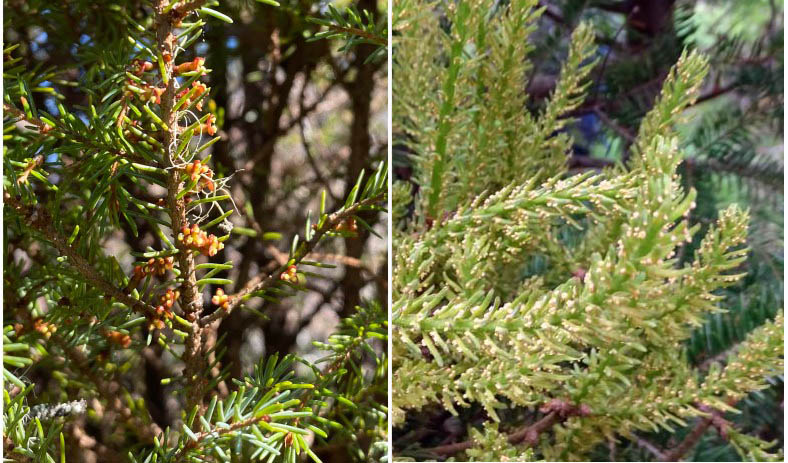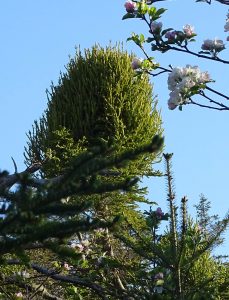It appears there are two causes of “Witches’ Broom” commonly observed on spruce and fir in NS, one Eastern Spruce Dwarf Mistletoe, a parasitic plant; and the second a Broom Rust (fungus)
View
– Eastern Spruce Dwarf Mistletoe
FA Baker et al., 2006 USDA Forest Service
– What’s the earliest flowering native plant in Nova Scotia? The quest continues 6Apr2021
Post on NSFN Apr 6, 2021
– Broom Rusts of Spruce and Fir
USDA Forest Health Protection Rocky Mountain Region • 2011
– What Is a Witches’ Broom?
American Conifer Society, Nov 22, 2019
– Witches’ Broom
Page on Missouri Botanical Gardens website

Left, Mistletoe in flower, photo by Bob Guscott March 30, 2021, Digby area. Right, Spermogonia of Fir Broom Rust (Melampsorella caryophyllacearum) on the underside of balsam fir needles; photo by David P June 19, 2021 St. Margaret’s Bay area
Flying squirrels often make their nests in Witches’ broom, view
Flying Squirrels – Elusive Forest Friends
by: Shawn Gerrow WINTER 1993/94 (NSDNR Conservation)
“Dwarf mistletoe sometimes creates dense witches brooms that may provide nest and rest areas for
small mammals.” NSDNR
“Eastern Dwarf Mistletoe (Arceuthobium pussillum): In Nova Scotia, eastern dwarf
mistletoe is a particular problem in white, black, and sometimes red spruce. There
appear to be two distinct zones of impact. In the Eastern and Central Regions damage
occurs primarily in coastal old field white spruce stands while in the Western Region
and eastern shore it is a problem in black and red spruce stands on poorly drained
sites.” DNR 2007
More on Yellow Witches’ Broom
From NS natr:
Yellow Witches’ Broom
Order: Uredinales
Family: Lymantriidae
Latin Name: Melampsorella caryophyllacearum Schr�ter
Common Names: Yellow Witches’ BroomIntroduction
This rust fungus causes abnormal shoot growth on balsam fir. Usually not severe, but can be a serious problem in Christmas tree plantations especially when balsam fir is grown on heavy agricultural soils where chickweed is common.Life History
This rust fungus infects fir buds in the spring and invades the young shoots. The perennial brooms grow slowly the first year and cause only slight, elongated swellings that are very difficult to detect on infected shoots. The following spring, buds on the infected twigs produce upright shoots that are thicker and shorter than normal. Needles of the new shoots are stunted, thickened, pale green and arranged in a spiral curve. During the summer, the needles become yellow; in autumn they die and drop off, leaving the broom empty of foliage during the winter. The broom produces a new crop of pale green needles in spring which release spores to infect its alternate host, chickweed. When the rust matures on the chickweed, it releases spores to infect the trees.Damage Symptoms
Trees with visible brooms. Needles that are stunted, turn from green to pale green to yellow, then die and drop off. Branches affected by the brooms are deformed by galls and cankers.

